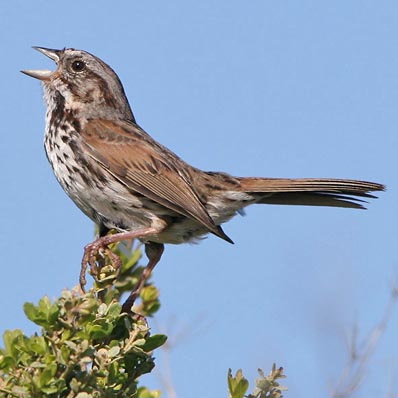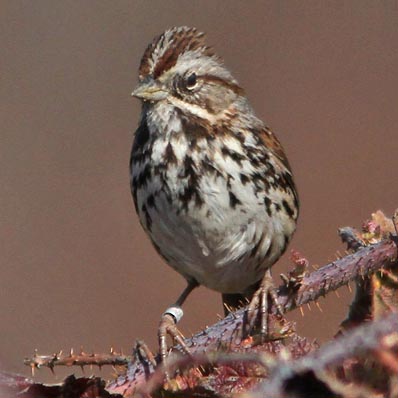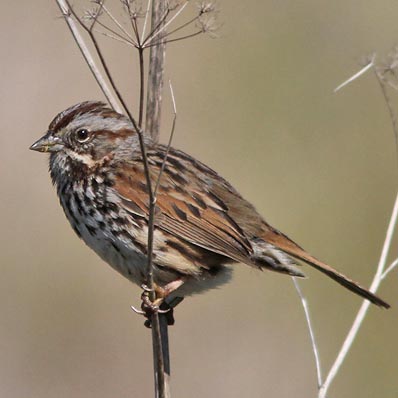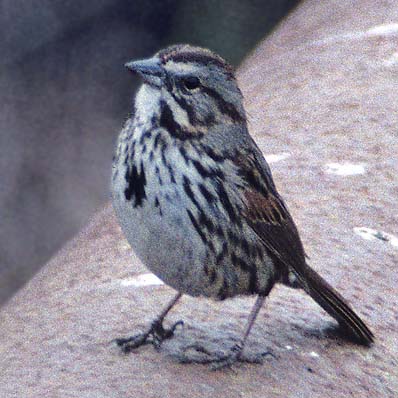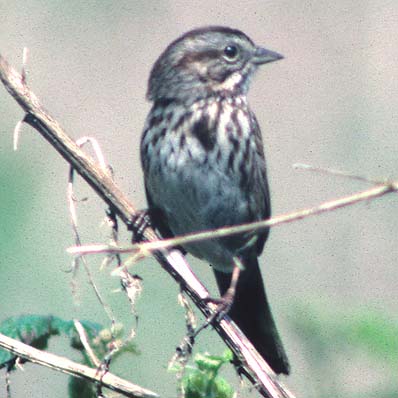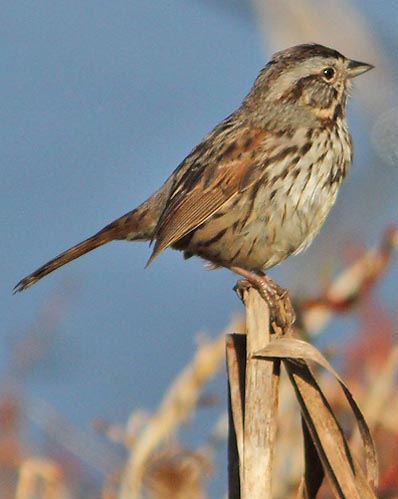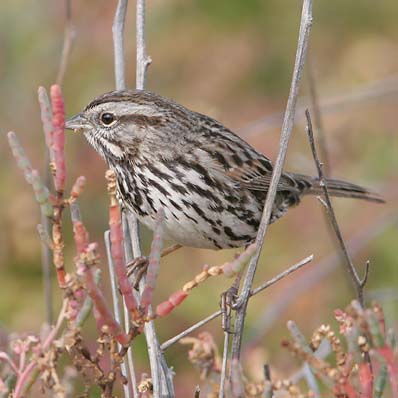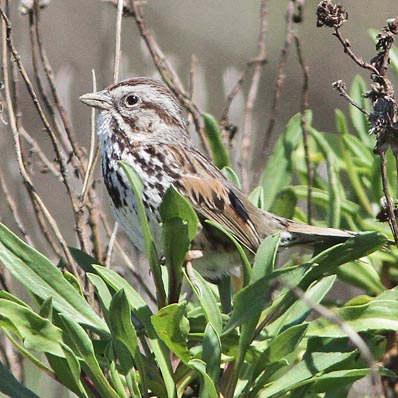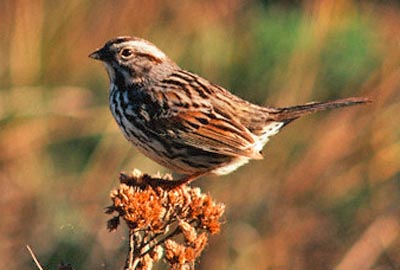
REVISED EDITION |
a web page by Don Roberson |

Song Sparrow Melospiza melodia is one of the most common — and most variable — birds in North America. There were once 52 named subspecies, but after recent major revisions (e.g., Patten 2001, Arcese et al. 2002, Patten & Pruett 2009, Patten 2010) there are now just 25 races in the world. Six subspecies are in Mexico, so in the U.S. and Canada there are now 19 subspecies. These range from M.m. maxima of the western Aleutian Islands — which is roughly the size of a California Towhee (photo, right, showing a Song Sparrow from Attu I. in the western Aleutians compared to a California Towhee) — to birds half that size that reside only in the salt marshes around San Francisco Bay.
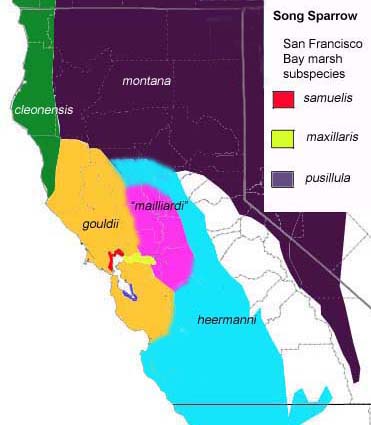 A
thorough revision of Song Sparrow subspecies by Patten & Pruett
(2009) has modified our prior understanding of geographic variation,
much of which was previously based on older work, going back to
Grinnell & Miller (1944). Patten & Pruett (2009) published new
range maps that show the geographic variation in northern California is
different than previously thought, and particularly affects Monterey
County. The map (right) is now corrected to follow the new taxonomy.
A
thorough revision of Song Sparrow subspecies by Patten & Pruett
(2009) has modified our prior understanding of geographic variation,
much of which was previously based on older work, going back to
Grinnell & Miller (1944). Patten & Pruett (2009) published new
range maps that show the geographic variation in northern California is
different than previously thought, and particularly affects Monterey
County. The map (right) is now corrected to follow the new taxonomy.
There are now 9 subspecies breeding in California, and 7 breed in northern California. The map shows our 7 breeding races plus the old taxa "mailliardi" in the western Central Valley [now merged into heermanni] but remains a "bird of special concern" in California's protection scheme (see below). Most of northern California's subspecies are resident, with only limited local movements, except that many birds of race montana (breeding in the cold northeast) migrate south in winter:
- cleonensis in the extreme northwest (Del Norte, coastal Humboldt, nw. Mendocino) — dark green on map
- montana in north-eastern California and east of the Sierra [montana includes the old "fisherella" that was used by Grinnell & Miller (1944)] — dark brown on map
- gouldii along coast and Coast Ranges from Mendocino Co. south to northernmost Monterey County (except the S.F. Bay salt marshes). [Race gouldii includes 'santaecrucis' of Grinnell & Miller (1944), which is now considered a zone of merging between gouldii and heermanni] — golden-orange on map
- local and rare San Francisco Bay salt marsh races: samuelis in San Pablo Bay [red on map], maxillaris in Suisun Bay and the northeast delta [yellow on map], and pusillula in south San Francisco Bay [dark purple on map]. Each is a California taxa of special concern (Shuford & Gardali 2008).
- "mailliardi" in the western Central Valley from the Glenn Co. to Stanislaus Co., called the "Modesto population" in Shuford & Gardali (2008). This race is not diagnosable, so it has been merged with heermanni; Patten (2001, 2009) However, since it is possible that this Song Sparrow is distinctive genetically, it is considered a California bird of special concern (Shuford & Gardali 2008) — purple-pink on map.
- heermanni, which is a widespread subspecies from the northern Central Valley and across almost all of Monterey County and down the southern California coast all the way to northwest Baja [it includes the old 'cooperi' of Grinnell & Miller (1944) [cooperi had been the considered the race in the coastal part of the range] — light blue on map.
It may be interesting to compare photos of various California coastal and Central Valley subspecies side by side: |
||||||
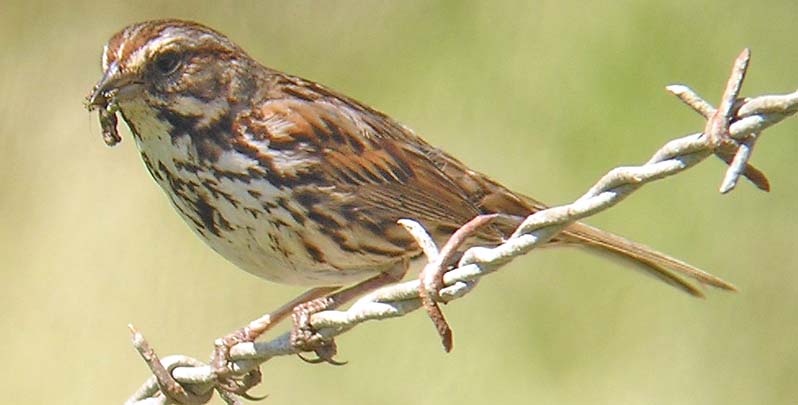 23 Apr 2004 Moonglow Dairy; carrying food to nest © D. Roberson |
||||||
|
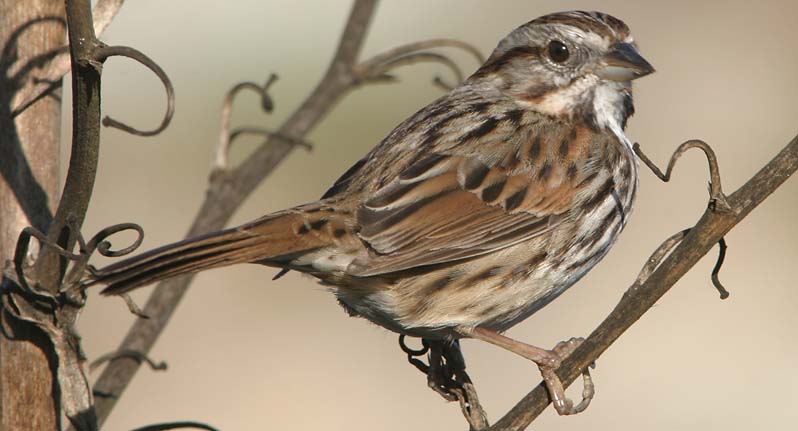
9 Jan 2007 Monterey Harbor © D. Roberson
To summarize, it is fair to say that most California Song Sparrows look alike — both those from the coast and the Central Valley — and that all are rather easily assigned to the "California" Song Sparrow group in eBird. The panel at right compares coastal populations. An example of the northernmost and southernmost races are in the first row: All these photos were taken between Jan-Apr, when Song Sparrow are getting somewhat worn (e.g., pale edges of upperpart and underpart feathers are wearing off). Song Sparrows are in fresh plumage in fall and very worn plumage in summer, and these seasonal differences are actually more dramatic in coastal California birds than the difference in geography, assuming that birds are at the same state of wear. |
|
San Francisco Bay saltmarsh Song Sparrows Things are different within the Salicornia habitat of the salt marshes around San Francisco Bay. There are three subspecies in these marshes, all of them resident birds, and all of them unique. Each is considered a "California species (subspecies) of special concern" because of the loss of tidal wetlands and the fragmented nature of its range (Shuford & Gardali 2008). The three subspecies are shown below. |
||||||
|
||||||
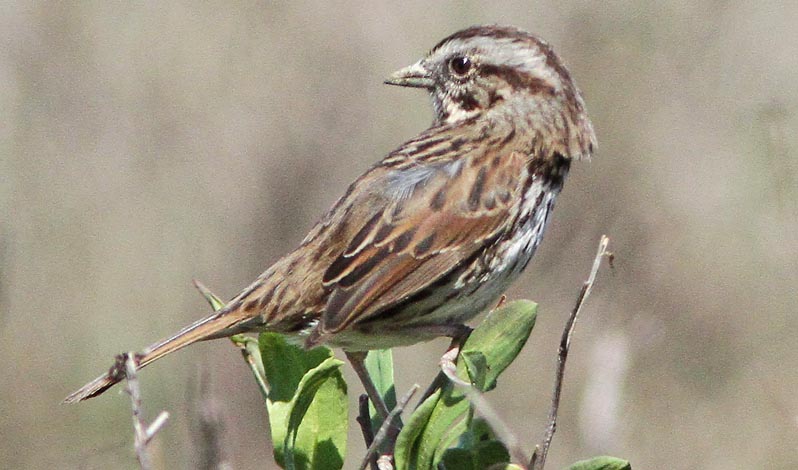 |
||||||
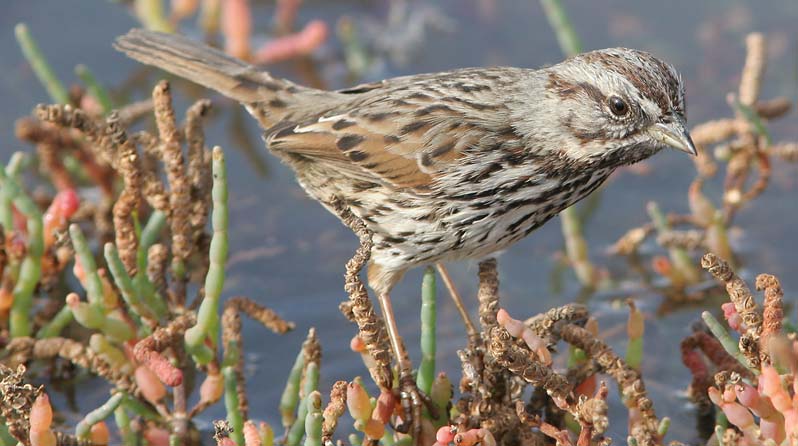 24 Nov 2007 Palo Alto Baylands, Santa Clara Co. © D. Roberson |
||||||
Bill
size can be a good character between these two saltmarsh Song Sparrows
and the more typical Song Sparrows throughout the rest of coastal
California. Compare the very tiny bills of both samuelis and pusillula
(above; San Pablo Bay and south S.F. Bay saltmarshes) with the
medium-sized bill of the local Monterey County resident race (below; heermanni). |
||||||
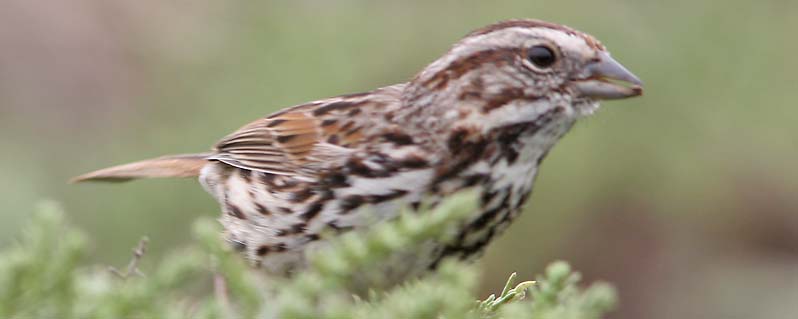 9 Jan 2007 Monterey Harbor, Monterey Co. © D. Roberson |
OTHER CALIFORNIA BREEDING SUBSPECIES There are three additional subspecies that breed in California which are not covered on this page. First, there is M. m. montana, the breeding bird of northeastern California. Many of these birds are migratory, and they are covered on the next page on migrants to coastal central California. The remaining two subspecies breed only in southern California. M. m. graminea is resident on some of the Channel Is. (photo just below). There were initially five named subspecies on the Channel Is and Los Coronados, off n. Baja (some extinct) but now all are merged in graminea (Patten & Pruett 2009]. The Channel Island birds are similar to coastal southern California heermanni, and are probably only identifiable on location.
The nesting birds in southeastern California (Salton Sea, Colorado River) are very distinctive. They are overall pale gray with rufous streaks, and are only sparsely streaked on the underparts. These are race fallax (right). The former name was 'saltonis' for southeast California birds but 'saltonis' has been merged with fallax of Arizona (Patten & Pruett 2009).
|
 29 Apr 2009 Hereford, Arizona © Tom Grey |
go to |
Photos: All photos © Don Roberson, except those credited to Tom Grey or Tom Bean, and used with permission, all rights reserved.
Acknowledgments: I thank Michael A. Patten and Peter Pyle for in-depth email discussions of geographic variation in Song Sparrows (with photo examples), and Tom Grey, Dennis Paulson, and Netta Smith for providing many photographs to review. Rita Carratello, Alex Rinkert, and Dan Singer also contributed to the discussions that brought this revised page together.
Literature cited:
Arcese, P., M.K. Sogge, A.B. Marr, and M.A. Patten. 2002. Song Sparrow (Melospiza melodia) in The Birds of North America, No. 704 (A. Poole & F. Gill, eds.). The Birds of North America, Inc., Philadelphia, PA.
Chan, Y., and P. Arcese. 2002. Subspecific diffentiation and conservation of Song Sparrows (Melospiza melodia) in the San Francisco Bay region inferred by microsatellite loci analysis. Auk 119: 641–657.
Grinnell, J., and W.A. Miller. 1944. Distribution of the Birds of California. Pac. Coast Avifauna 27. Cooper Ornith. Soc.
Patten M.A. 2001. The roles of habitat and signaling in speciation: evidence from a contact zone of two Song Sparrow subspecies. Ph.D. dissertation, Univ. Calif., Riverside.
Patten, M.A. 2010. Evolution and historical biogeography of a Song Sparrow ring in western North America, pp. 329-342 in Evolutionary Biology – Concepts, Molecular and Morphological Evolution, Chapter 20 (P. Pontarotit, ed.). Springer-Verlag, Berlin.
Patten, M.A., and Pruett, C.L. 2009. The Song Sparrow, Melospiza melodia, as a ring species: patterns of geographic variation, a revision of subspecies, and implications for speciation. Systematics and Biodiversity 7: 33-62.
Roberson, D. 2002. Monterey Birds, 2d ed. Monterey Pen. Audubon Soc., Carmel, CA.
Shuford, D., and T. Gardali, eds. 2008. California Bird Species of Special Concern. Studies of Western Birds 1. Calif. Field Ornithologists, Camarillo, CA, and Calif. Dept. Fish & Game, Sacramento.
